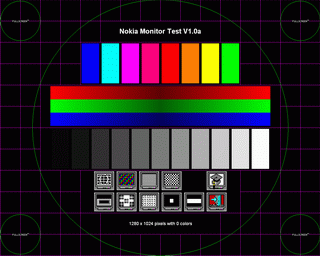HOME
TOPICS
ABOUT ME
I've found that any time I set up a monitor, I use both of these programs.
Al Fasoldt's reviews and commentaries, continuously available online since 1983
Two free Windows programs help adjust your display
Feb. 10, 2002
By Al Fasoldt
Copyright © 2002, Al Fasoldt
Copyright © 2002, The Post-Standard
Years ago when I bought my first modern computer, I adjusted the display by putting a word-processing document on the screen and tweaking the picture so the text looked sharp and clear.
How times change! I've been having fun lately with two free monitor-adjustment programs for Windows that can turn any PC user into a graphics maven in minutes. They're equally good, so I'll tell you about them in alphabetical order.
The first is the Monitor Test from Nokia, the Finnish electronics company. The Nokia test program dates back many years -- it's not even mentioned on the Nokia Web site any longer -- but is still a great way to test and adjust your Windows monitor. You can get it from www.freepctech.com/rode/004.shtml.
The Nokia program has a gorgeous series of test patterns -- I sometimes run it just to look at them again -- and they make it easy to adjust brightness, contrast, proper shape, overall image size and much more.
Nokia test program has helpful color bars.
 The
brightness and contrast test screen is one of the simplest
ways I have ever seen to adjust the mysterious
"gamma," which on nearly every Windows monitor is
set totally wrong. (I've written about this before, so
I'll simply mention that most Windows monitors suffer
from a brightness level that's too high and a contrast
level that's too low. Even the act of calling them
"brightness" and "contrast" is a
frustration to me, since they actually control the white
level and the black level.)
The
brightness and contrast test screen is one of the simplest
ways I have ever seen to adjust the mysterious
"gamma," which on nearly every Windows monitor is
set totally wrong. (I've written about this before, so
I'll simply mention that most Windows monitors suffer
from a brightness level that's too high and a contrast
level that's too low. Even the act of calling them
"brightness" and "contrast" is a
frustration to me, since they actually control the white
level and the black level.)The second monitor tweaker is Test Screens by Johannes Wallroth, a programmer from Berlin, Germany (www.programming.de). Wallroth's utility is ideal for testing the clarity of a modern monitor because it uses the tiniest possible type size in some of the tests. If you can clearly read everything in the Wallroth tests, your monitor is doing well.
I've found that any time I set up a monitor, I use both of these programs. Each one does one or two operations better than the other, and both come at the right price.